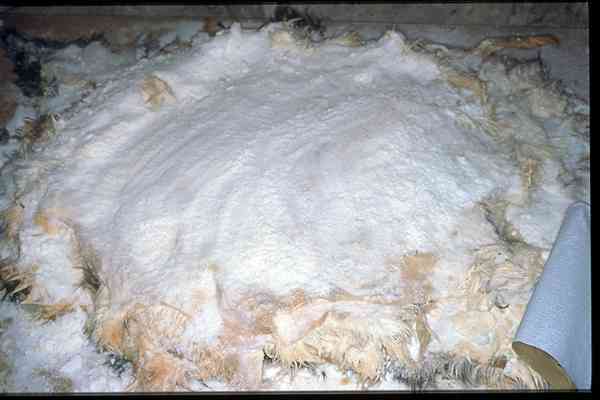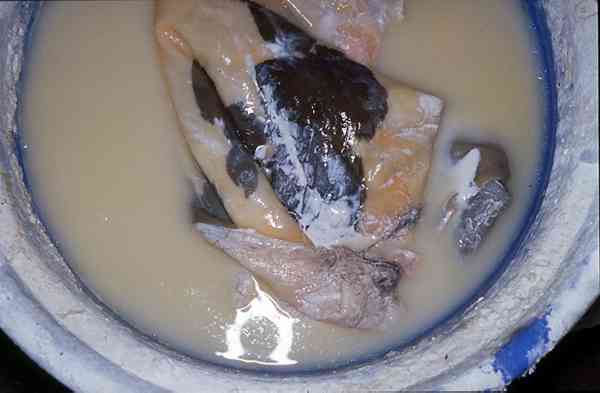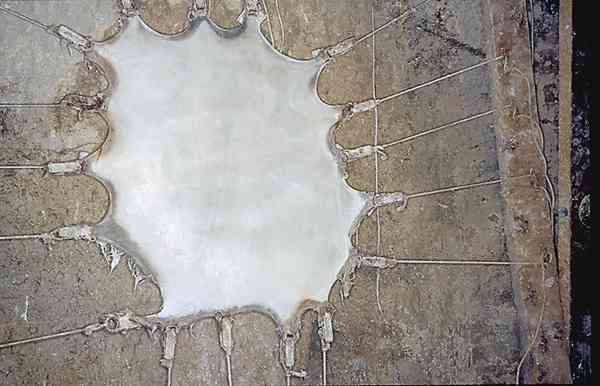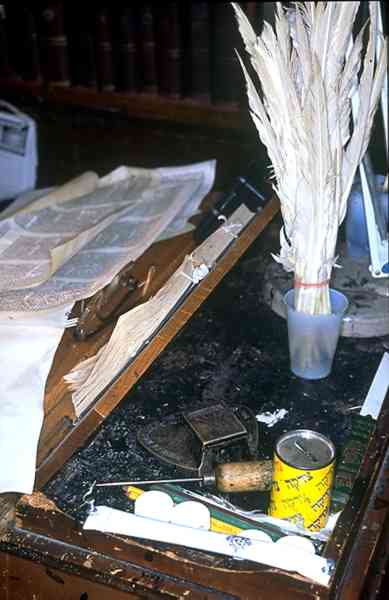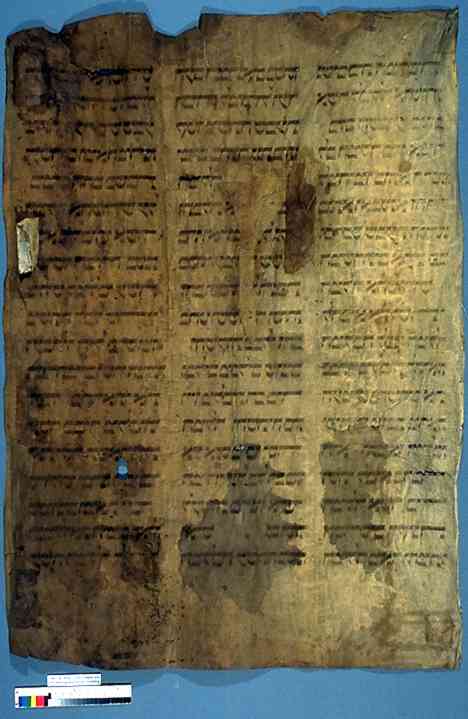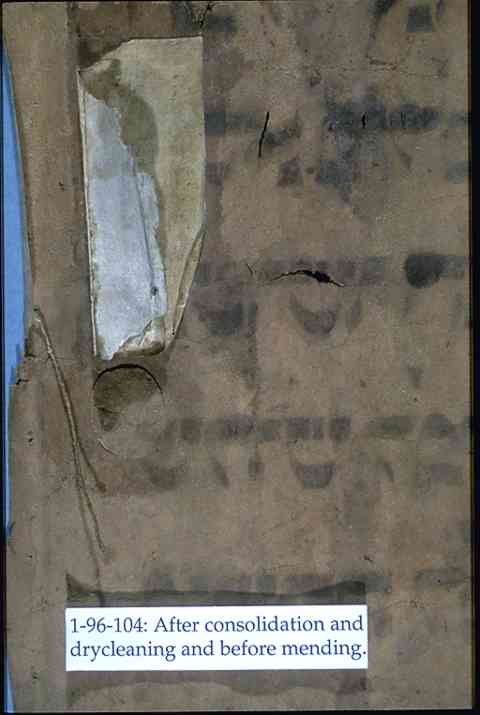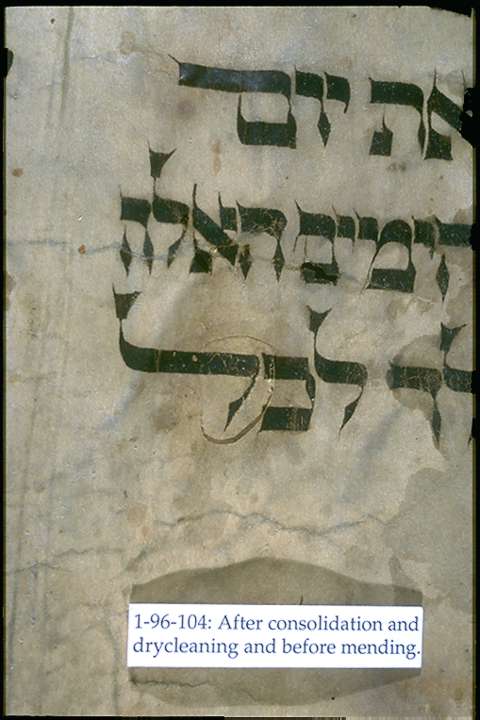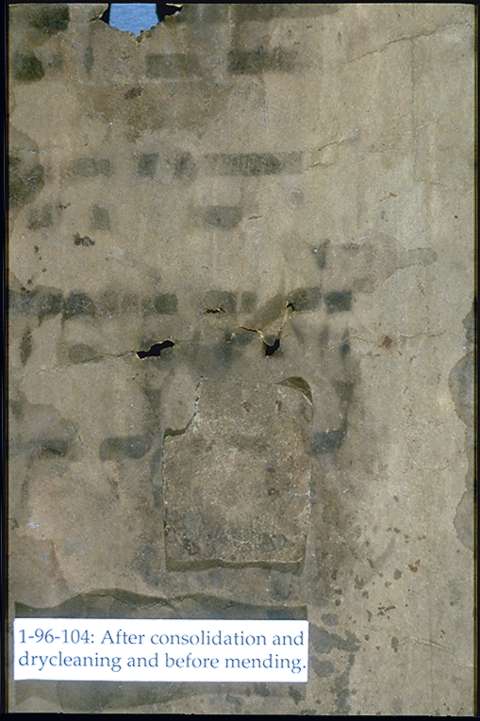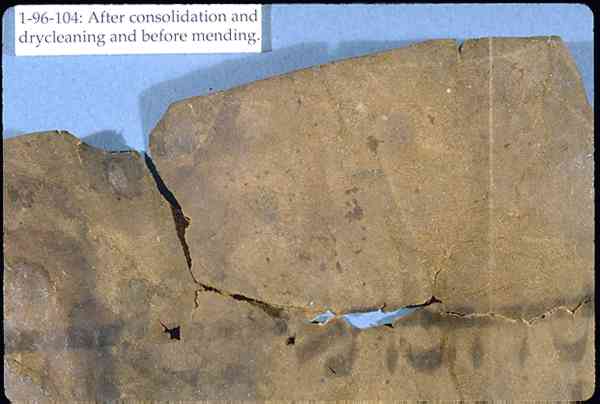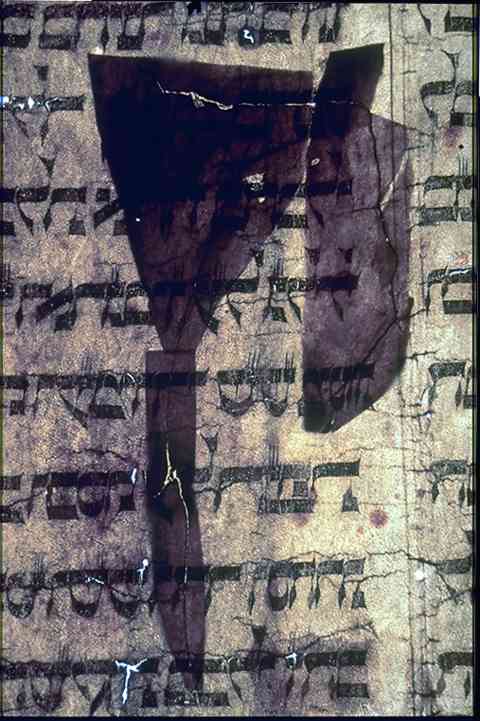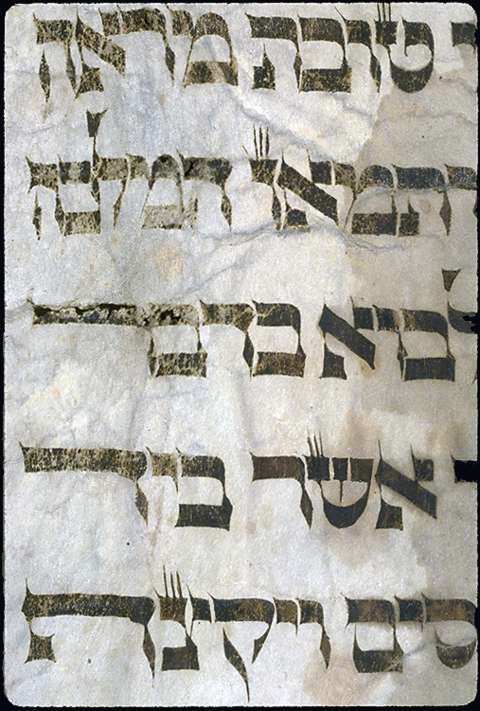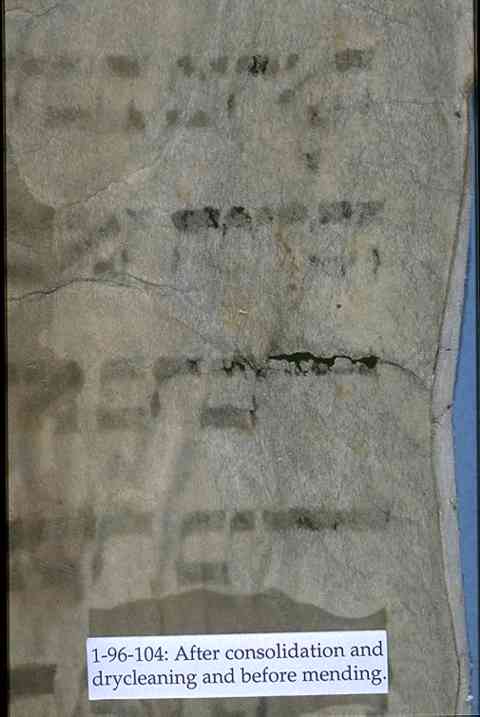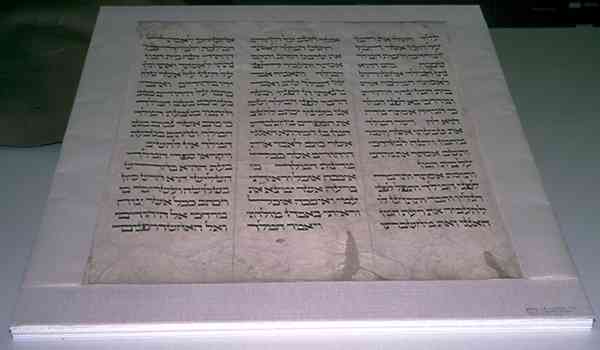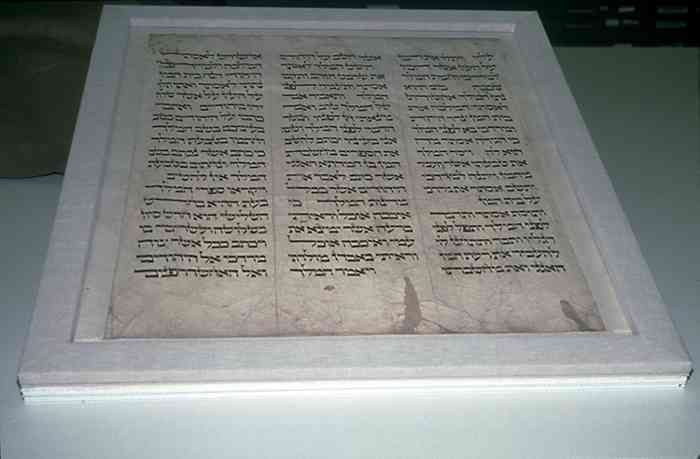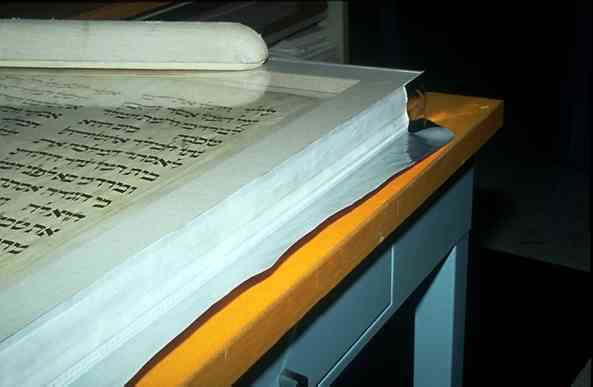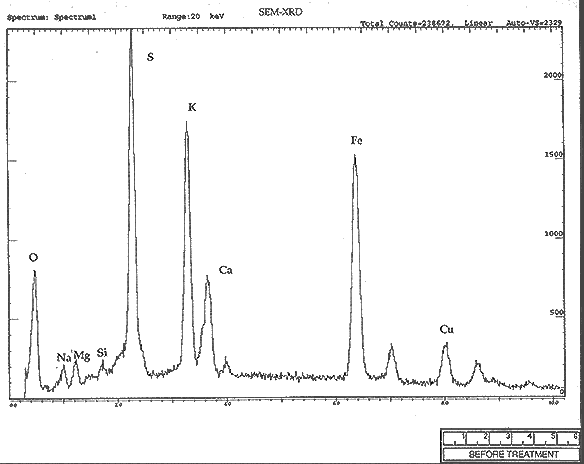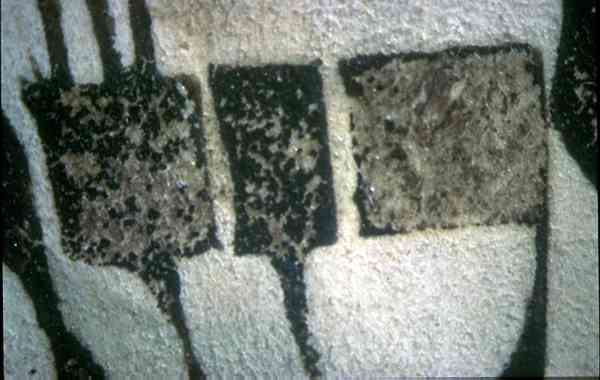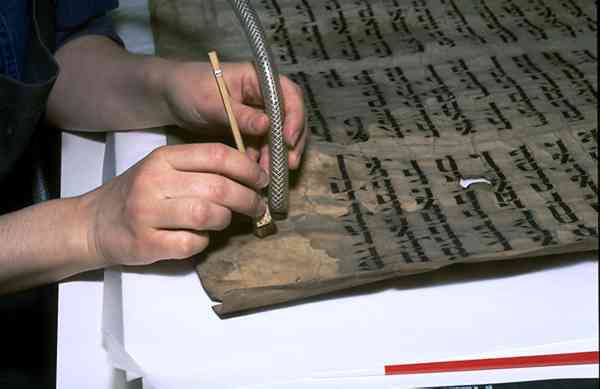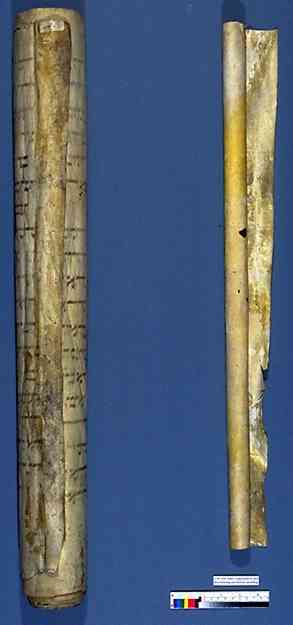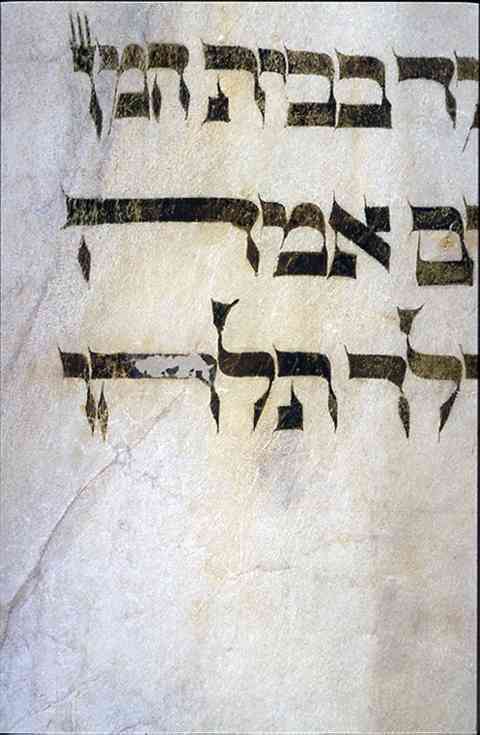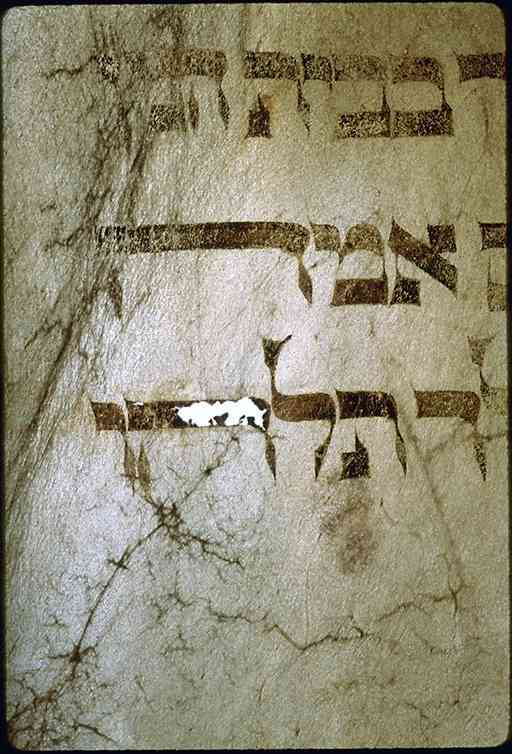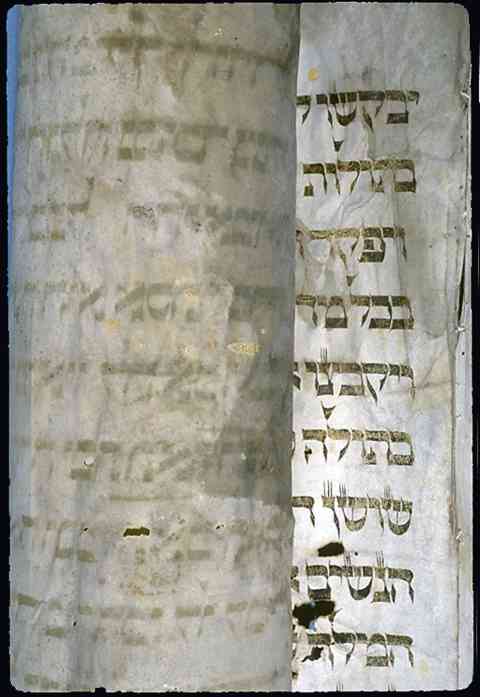The Gantse Megillah : Conservation
of a 14-15th Century Parchment Esther Scroll
by Annlinn Kruger Grossman
Introduction
Following the conventions of curatorial nomenclature, one might reasonably read the Gantse Megillah as indicating something of the provenance of an individual megillah or Hebrew scroll. In fact, this Yiddish phrase translates as "the whole story." The shift of focus, between object and story, may signal a different view of treatment, dependent on concern with the integrity of the object or the primacy of the text.
In Jewish law, the Megillat Esther , like the Torah, is placed in the category of scriptural objects which convey holiness. The Jewish scribe, or sofer, is accountable for each word; the title is derived from the same root as "to count." As a cultural artifact in a public institution, the Ashkenazi Megillat Esther in the Hebraic collection of the Library of Congress retains its ritual function to present the story of Esther -who defied protocol to save her people- but presents its own story as well. The work of the sofer and the work of the conservator are part of this story in which the play of tradition and innovation, in the service of preservation, is a continuing theme.
Notes on the Tradition of Jewish Manuscript Production
As conveyed in scripture, Jews are enjoined to ". . . write you this song" (Deuteronomy 31: 19). These words were interpreted by rabbinic authorities to mean that "it is obligatory to write a beautiful scroll of the Torah, with choice ink, with a fine reed pen, written by an expert penman on well finished parchment" (Tractate Soferim, Chapter 11); the law was extended to include other sacred texts. This universal behest is the particular responsibility of the sofer.
Jewish life is informed by study and Jewish iconography is replete with images depicting the centrality of the written word - but it is destitute of images of scribes. Indeed, Moses, who may be considered the first sofer, and Ezra, the first so named, are typically shown transmitting the law, or, as it were, upholding the law, rather than writing it. It is possible that this lacuna results, in part, from a hesitancy to portray the production of sacred texts. Inevitable loss over time and the intentional destruction of Jewish sacred manuscripts in Christian Europe over centuries, insure that we cannot have the whole picture.
Fittingly, then, we must turn to the texts themselves. Mention is made of sofrim in scriptural texts, but, what we know of scribal practice comes primarily from redactions of the law as contained in halachic treatises -such as the Talmud, Mishneh Torah, and Shulchan Arukh, commentaries on these texts- and from colophons. It is to such texts that sofrim through the ages have turned for guidance in their work. There do not appear to be separate technical manuals.
Although some preventive and reparative measures are recorded in halachic texts -such as injunctions not to drape scrolls over the backs of chairs and instructions for how to remove wax by flexing the parchment or by warming the verso of the sheet with a candle--the emphasis is on the identification of allowed materials, formation of letters, configuration of the written page, construction of the scroll, ritual purity of the copyist, and, above all, the faithfulness of the text.
The primacy of the text in halachic discourse and the primacy of this discourse in Jewish life -as a reflection of and guide for practice- affects the production, use, and treatment of sacred texts. Texts are produced to be used for communal and private study and devotional observance; they are instrumental rather than iconic. They are kept in repair for as long as possible and when they are no longer ritually fit for use--usually when the text is no longer readily legible--they are hidden away or buried.
The sofrim, like the rabbinic authorities, were engaged in the intellectual life of the peoples among whom they lived and conversant in their technological and aesthetic vocabularies. Just as rabbinic writings display knowledge of contemporary language and ideas, Hebrew script itself evolved in rapport with local influences; the Ashkenazi script of Northern Europe is clearly influenced by Latin script, and the formation of its distinctive pattern of broad and narrow strokes, and straight and curved lines, is dependent on relinquishing the traditional reed pen and adopting the quill.
The history of Jewish manuscript production is a history of change of materials, technique and style, often, apparently, introduced by the sofrim themselves. The easily water soluble carbon based inks, suitable to the dry environmental conditions of Egypt were replaced by metallic sulfate -vitriol- inks more stable in temperate climates. The acidic/enzymatic solution preparation of skins for writing, outlined in early halachic texts and successfully used in the warm environs of the Mediterranean area, was replaced by a basic/limewater solution preparation more serviceable in the cooler temperatures of northern Europe. With the introduction of a soft surfaced parchment, worked so as to obliterate the differences between hair and flesh sides, rulings, originally done with a sharp point, were later done in ink or with a "pencil" composed typically of 3/4 lead and 1/4 brass. the use of pictorial representation in Hebrew manuscripts begins with the appearance -over rabbinic objection- of words wrought to produce micrographic designs and images. While famous for the veracity of their textual transcription of the words of the law, the sofrim, have been innovators of the law in the technical and aesthetic areas of their profession.
It is through the protocols of exegesis and communal practice that the extraordinary textual conservatism of Judaism engenders a flexible and responsive body of law. The discursive style of rabbinic discourse displays the processes of change in the development of the law, as shown in this quote from tractate Sefer Torah Chapter 2, rule 12: 62a-b): "A tear in a [Torah] parchment sheet may not be joined with glue, nor is it permitted to write on a patch, nor may the sheets be sewn together on the written side. Reb Simeon ben Eleazar said in the name of Reb Meir [a torn sheet] may be joined with glue and it is permitted to write on a patch, but it is forbidden to do the sewing on the written side. If a scroll is torn, a patch may be placed on the outside."
Change, though continuous, has been selective. The use of the codex format has not replaced scroll production, the introduction of paper has not replaced the use of parchment, and the development of printing and electronic technologies have not replaced handwritten texts.
Fig. 1. Salted skins.
Fig. 2. "Baldie" ("hairless" skin) in limewater bath.
Contemporary sofrim, like conservators, are among the few professionals working with parchment today. Intrigued by this coincidence, and curious about the work of the sofrim , I contacted Rabbi Yehuda Clapman who graciously invited me to his home to discuss his work. Rabbi Clapman is among the small number of sofrim who prepare their own parchment. He salts the skins (Fig. 1) soaks them in limewater (Fig. 2), stretches them (Fig. 3), works them with a semi-lunar knife, and when dry, sands them. Rabbi Clapman also prepares his own quills, ink, and parchment glue. He marks the parchment sheets with an awl and cuts patches and scrapes off mistaken or damaged letters with a razor blade (Fig. 4).
Fig. 3. Skin on stretching frame.
Fig. 4. Sofer's writing desk with quills, awl, and charity donation box.
Throughout our talks, Rabbi Clapman emphasized the religious requirements and spiritual dimension of his work. In discussing consolidation with acrylic spray--an accepted practice among many sofrim--Rabbi Clapman considered its impact on the object, its toxicity, and the destructive and harmful issues involved in reversibility, but founded his argument against this practice on the fact that it presents a barrier to the commandment "to write with ink on parchment" (Jeremiah 36: 18).
Today, the Torah and the Megillat Esther are written with ink on parchment and sewn in scroll form. While the Torah testifies to Jewish survival, the story of Esther exemplifies it. So strong was the appeal of this story to the Jewish community that it seems the text was canonized in deference to popular desire.
The Megillat Esther
The status and use of the Megillat Esther is reflected in the laws pertaining to its construction and the customs pertaining to its use; knowledge of these help to explain artifacts of production and use and provide guidance to treatment. Rabbi Meir of Rothenberg, in 13th century Germany, wrote that "all the rules that apply to the Torah scroll apply to the writing of Esther . . . since Esther is called a scroll it should be sewn with giddin (dried tendon) but since it is also called a letter only three seams are required to be sewn with tendon, the others may be sewn with threads of flax."1 Because of the centrality of the theme of the letter, it is an established custom to spread out the scroll and, as it is read, fold it like a letter. Over time, some restrictions on the construction and treatment of sacred scrolls were revised, most notably, in the case of the Megillat Esther, prohibitions concerning decoration. Many surviving megillot, are diversely crafted and ornamented objects incorporating wood, ivory, metal, textile, paper, and painted and printed media components.
The library of the Jewish Theological Seminary of America has an extensive collection of megillot Esther.2 I am very grateful to conservators Margarita Blank and Nellie Stavisky for showing me their work on this collection which displays a variety of decorative and reparative elements including some sewn silk lined parchment scrolls. It has been suggested such linings were first used to conceal the unattractive versos of tanned skins and, later, with the use of parchment, as a decorative and protective element; sewn silk linings also appear as supports for damaged sheets. There is an unusual example of an adhered paper lining, mechanical removal of which revealed parchment mends. There is also an extreme example of an, unfortunately, not altogether uncommon practice of mending with stiff, heavy parchment. Examples of mending parchment with paper and heavy parchment were also found in the collections of the Hebraic Section of the Library of Congress and the Library of Agudas Chassidei Chabad. In all these collections a typical method of mending appears to be adhered patches and inserts of relatively appropriate weight parchment.
I hope that this brief survey has given a sense of the range of materials and strategies historically used to produce and repair Megillot Esther. While, on evidence of rabbinic sources, some of this work was done by sofrim and some attention was given to the religious regulation of repair work, the same evidence leads me to suggest that repair work, except in so far as it affected the text, and perhaps the margins and sewing, was not a primary concern of either religious authorities or ritual workers, and further, that many of the repairs we find were probably done by various individuals concerned with keeping body and soul together, as it were, to prolong the life of the object.
Conservation of the Ashkenazi Megillat Esther At the Library of Congress
With the provenance of many Hebraic objects lost to the vicissitudes of Jewish history, it is not usually possible to know the ritual status of items prior to their inclusion in private and public collections. Traditionally, items declared unfit for ritual use were buried or put away in a genizah or hiding place; such items have found their way onto the collectors marketplace, and indeed, one such transaction lead to the discovery of the Cairo Genizah where thousands of Hebraic items had been stored from the 11th to the 19th Century; in 1897 a visit to the Cairo Genizah lead Solomon Schecter, then Reader in Rabbinics at Cambridge University, to write:
"It is a battlefield of books, and the literary productions of many centuries had their share in the battle, and their disjecta membra are now strewn over its area. Some of the belligerents have perished outright, and are literally ground to dust in the terrible struggle for space, whilst others, as if overtaken by a general crush, are squeezed into big, unshapely lumps, which even with the aid of chemical appliances can no longer be separated without serious damage to their constituents".3
Collections, such as those at the Library of Congress, are situated somewhere between the schul 4 and the genizah. While sacred objects in their care are now used in cultural, rather than religious, rituals of study and display, with any luck at all, they are not yet consigned to oblivion; although not necessarily fit for religious use, sacred items may be presented, not simply as memorials to loss, but as testimony to endurance.
It is unlikely that a patron primarily concerned with ritual fitness would consult a conservator. Nonetheless, within the ethical definition of our profession we recognize the responsibility to be knowledgeable of ritual concerns which may be affected by treatment and to avoid actions which would preclude treatment for ritual fitness at a later date. In the case of Hebraic objects, I would suggest that: repairs in no way visually obliterate, mask, or restore damage or loss of textual elements; margin dimensions be maintained; and if any materials of animal origin are used then they should derive only from kosher animals. It is understood in many Jewish venues that scrolls which are damaged beyond the parameters of ritual fitness may have historic significance which overrides any impetus to either return them to ritual use or put them away.5 It then becomes the role of the sofer to make a new copy of the text and the role of the conservator to stabilize the object.
Fig. 5. Ashkenazi Megillat Esther from the collection of the Hebraic Division of the Library of Congress.
It is in this context that we approached the treatment of the (Fig. 5) Ashkenazi Megillat Esther, some details of which are discussed below. On the basis of such codicological evidence as, the equalization of the hair and flesh sides of the parchmen; pricking patterns, faint ink rulings at the right and left margins and at the top of the lines of writing, and the script, it is believed that the scroll is from late 14th -early 15th century southern Germany. It is unusual because of its age and size, and the magnificent austerity of its script--ornamented only with the taggin, or crownlets reserved for specified letters in the writing of the Torah. Although illuminated halachic and ritual codices survive from the same provenance, it seems that, in regard to the Megillat Esther , rabbinic iconoclasm had not yet been overwhelmed by the seductions of pictorial imagery.
Fig. 6. First sheet of scroll, recto.
Fig. 7. First sheet of scroll, verso.
Fig. 8. Detail of verso of first sheet showing circular patch (possibly applied before writing), white parchment tab to reinforce sewing at join, and remnant of giddin.
Fig. 9. Detail of recto of first sheet showing compensation for loss--possibly an artifact of biological or mechanical processes which occurred prior to writing.
Fig. 10. Detail of verso of first sheet showing patch on loss shown in Fig. 9.
Fig. 11. Detail of recto of first sheet showing tear and loss.
Fig. 12. Detail of verso of first sheet showing tear and loss.
Fig. 13. Detail of recto of first sheet showing mends.
Fig. 14. Detail of verso of first sheet showing mends.
Fig. 15. Detail of verso of first sheet showing mends (transmitted light.)
Fig. 16. Detail of recto of first sheet showing damage to support and medium.
Fig. 17. Detail of verso of first sheet showing damage to support and medium.
Fig. 18. Detail of damaged area shown in Figs. 16 & 17 (transmitted light.)
Separation of the first sheet was necessitated by its unstable condition (Figs. 6 & 7) and was justified by the fact that only remnants of an early sewing with giddin remained and the scroll had previously been resewn throughout with cotton/linen thread. While the depredations of use and environmental exposure are more extreme on this sheet than elsewhere, it can serve as an encyclopedia (Fig. 8) of construction, damage, and repair elements typical of this object, including: preparatory mends (Figs. 9 & 10); tears and losses (Fig. 11 & 12); repairs (Figs. 13, 14 & 15); and support fragility due to inherent vice, abrasion, and media degradation (Figs. 16, 17, 18 & 19). 6
Fig. 19. Detail of verso of first sheet showing damage to support by medium.
Fig. 20. Parchment sheet held in place on support by Japanese paper attachments.
Fig. 21. Verso of support structure showing "windows" cut for silica gel and charcoal tiles.
Fig. 22. Linen wrapped spacer.
Fig. 23. Elements of housing structure.
Fig. 24. Ink analysis.
Media analysis by scanning electron microscope-x-ray diffraction shows a profile consistent with those of known iron gall ink samples (Fig. 24); the iron reading cannot otherwise be readily accounted for by artifactual, environmental, or reactivity factors.
Fig. 25. Detail of ink.
The media was consolidated with parchment size diluted with a water/isopropanol solution. The dilution was adjusted for varying media conditions (Fig. 25); this, as well as observation, during testing, that any movement of size onto the support caused irreversible changes in surface texture and color, precluded any overall method of consolidant application. (While the observed changes may have been due to a mechanical compacting of surface fibers, it has been noted that the highly worked parchments of this provenance--because of the extremely vulnerable configuration of the fiber structure--are particularly susceptible to gelatinization upon the introduction of water.7 ) Shortly after the initial application of size each letter was lightly burnished through silicon release paper and another application was made.
Fig. 26. Cleaning the recto of the first sheet using a soft brush and "customized" variable suction vacuum cleaner.
Fig. 27. Heavy parchment attachment previously adhered to last sheet of scroll.
Once the media was consolidated, treatment proceeded with dry-cleaning using soft brushes and a variable suction vacuum cleaner (Fig. 26) and also the soft feathered edges of small pieces of torn blotter. In order to stabilize the last sheet, so that it could be cleaned, a distorting and disfiguring parchment attachment was mechanically removed (Fig. 27).
Fig. 28. Paper mend on verso of parchment sheet.
Fig. 29. Paper mend as it appears on recto of parchment sheet.
Trials of mending using LC heat-set tissue paper with a previously applied layer of ethanol activated adhesive (lens tissue coated with acrylic resin dispersions--Rhoplex AC-234 and AC-73) have proved mechanically and aesthetically successful (Figs. 28 & 29); at this time, considering the characteristics and condition of this parchment, I am inclined to continue with these materials and technique.8 Other questions remain regarding the appropriate conservation treatment of several elements including sewing, adhesive removal, stain reduction, humidifying and flattening, and repair or replacement of historical construction elements such as parchment strips adhered to reinforce the sewing.
Conclusion
Fig. 30. Paper mend in transmitted light.
31. Recto/verso view of scroll and various artifacts of construction, use, and age.
I hope that this presentation has shown how a confluence of interest may bring together sofrim and conservators in the preservation of Jewish sacred objects. I feel that a better acquaintance with the tradition informing prior handiwork will benefit our efforts and I hope that interest in this tradition among conservators may lead to outreach to modern sofrim and benefit their work as well. Current treatment is part of the continuum of examples which constitute the identity of this object; the goal of this work has been to secure the physical testimony of the scroll against the insults of inherent vice, use, and time, while preserving the traces of history. Obviously this is still not the gantse megillah. (Fig. 30).
Acknowledgments
I would like to thank Tom Albro, Doris Hamburg, Jesse Munn, and Heather Wanser of the Conservation Office of the Library of Congress for their support. Michael Grunberger and Peggy Pearlstein of the Hebraic Division of the Library of Congress provided invaluable assistance in locating objects and references. Frank Hengemihle of the Research and Testing Laboratory of the Library of Congress performed the ink analysis, and most helpfully, explained it. Hugh Phibbs of the National Gallery of Art continues to inform my thinking on and production of conservation housing. Nellie Stavisky and Margarita Blank of the Conservation Office of the Jewish Theological Seminary generously shared their thoughts on the production and repair of Megillot Esther so that I could draw on their wide experience, selected examples for me to view, and allowed me to use their slides in my presentation. Dr. Menahem Haran of the Hebrew University of Jerusalem and Dr. Abraham J. Karp of the Jewish Theological Seminary took time from their scholarly work to help me in my fledgling effort. Rabbi Shalom Dovber Levine, Head Librarian of Agudas Chassidei Chabad Ohel Yosef Yitzchak - Lubavitch Library, allowed me to examine and photograph many items from the Rare Book collection. I would especially like to express my gratitude to Rabbi Yehuda M. Clapman, Sofer, for inviting me to view and discuss his work and to his family for welcoming me to their home. From all my teachers I have learned
Notes
1. Rabbi Meir of Rothenberg. 1947. Agus.
2. Friedfertig, L. L., 1996. Une Collection Exceptionnelle. Shalom 26: 85-89.
3. Carmi, T., 1981. The Penguin Book of Hebrew Verse. Penguin Books.
4. There is, perhaps, no adequate English translation for this Yiddish word signifying the place of worship and study which, with the home, is the center of ritual activity.
5. Indeed, for the first major exhibits of materials from the Cairo Genizah, mounted in Israel and New York in 1997, preparatory work on the objects was performed by conservators.
6. This action was later cited as precedent in separating another portion of the scroll. The Ashkenazi Megillat Esther is a highly valued holding of the Hebraic Division and, as such, has been included in the Library's exhibit of Hebraic objects -From the Ends of the Earth. When this exhibit was mounted at the Library of Congress, the entire scroll (except for the first sheet) was on display. In consideration of the vulnerability of the scroll and the rigors of shipping and display, when the exhibit was prepared for travel to other venues, only one representative sheet of the scroll was included. Given the precedent of the removal of the first sheet, and after verifying that there was no original sewing intact, the decision was made to remove this additional sheet.
Before separation, a record of the joins was produced by tracing the sewing and the profile of each sheet edge. The scroll was rolled so that the verso of the join was accessible. Polyester film was placed over the join and glassine placed over the polyester film. The tracing was done with soft colored pencils. The joins were also photographed producing documentation of the overall appearance of the sheet as well as details; there are 4x5 color transparencies, 4x5 black and white photographs, and 35mm color slides.
The threads were cut at the sewing holes, with a small pair of scissors, and then gently pulled out with blunt-tip tweezers. Only short segments of thread were pulled through the holes to avoid the stresses of pulling through long threads. The sets of sewing holes were examined and the most stable identified. These were then sewn through with linen thread to join the parchment sheet to lengths of Japanese paper.
A piece of 6-ply alkaline mat board was wrapped in washed linen. the parchment sheet was positioned on this support and the paper attachments were wrapped around the edges and secured, with pressure sensitive adhesive tape, to the verso of the board (Fig. 20). an additional support was constructed of alkaline mat board, alkaline corrugated paper board, and corrugated plastic board (made primarily of a polypropylene and polyethylene copolymer) in which "windows" had been cut to accommodate silica gel and charcoal tiles (Fig. 21). A spacer was constructed of the plastic corrugated board and wrapped in washed linen (Fig. 22).
The elements of the housing were assembled and "sandwiched" between pieces of 1/4" acrylic sheeting. Strips of archivally sound paper were adhered with a very small amount of polyvinyl acetate adhesive to the edges of this package to create a smooth surface and then pressure sensitive adhesive tape was applied. To prevent shifting of the package elements, and to reduce stress on the tape, strips of spun-bounded polyethylene olefin fiber material (Tyvek) were adhered with double-sided pressure sensitive adhesive tape around the edges of the package. Drawing upon the work of Hugh Phibbs, coordinator of Matting and Framing Services at the National Gallery of Art, the package was further stabilized by wrapping the verso and up over the edges with a sheet of aluminized polyethylene and nylon barrier film (Marvelseal) which was secured with double-sided pressure sensitive adhesive tape along the sides and with pressure sensitive adhesive tape on the top acrylic sheet (Fig. 23).
I have included this description as an indication of the implications of exhibition demands for conservation strategies and also because of the significance of housing -whether for storage, study, display, or travel- as conservation treatment.
7. Cains, Anthony. 1984. Repair Treatments for Vellum Manuscripts. In the Conservation of Library and Archive Materials and the Graphic Arts, ed. G. Petherbridge. London: Butterworth Scientific Ltd.
8. However, as brought to my attention by Dr. Menahem Haran of the Hebrew University of Jerusalem, Dr. Z. H. de Groot of the Netherlands has succeeded in producing a soft, extremely thin parchment; it is possible that this will prove useful for some of the mending.
Selected References
Avrin, Leila. 1991. Scribes, Script and Books: The Book Arts from Antiquity to the Renaissance. Chicago: American Library Association / London: The British Library.
1981. Micrography as Art. Etudes de Paleographie Hebraique. 43-68.
Beit-Arie, Malachi. 1981. Hebrew Codicology. 2nd ed. Jerusalem: Israel: Academy of Sciences and Humanities / Paris: Centre National de la Recherche Scientifique.
1986-87. Paleographical Identification of Hebrew Manuscripts: Methodology and Practice. Jewish Art (formerly Journal of Jewish Art) 12-13: 15-44.
Carvalho, David N. 1904. Forty Centuries of Ink. New York: The Banks Law Publishing Co.
Cohen, A. , ed. 1965. The Minor Tractates of the Talmud ( Megillah, Sefer Torah, Soferim). London.
Cowan, P. 1986. A Torah is Written. Philadelphia: Jewish Publication Society.
Encyclopedia Judaica. 1971. Jerusalem: Keter Publishing.
Friedfertig, Lory L. 1996. Une Collection Exceptionelle. Shalom, Le Magazine Juif Europeen 26: 85-89.
Goodenough, Erwin. 1943. Early Christian and Jewish Art. Jewish Quarterly Review, 33: 403-417.
Greene, Virginia. 1992. Accessories of Holiness': Defining Jewish Sacred Objects. Journal of the American Institute for Conservation Vol. 31, Number 1.
Gutmann, Joseph. 1965. Images of the Jewish Past. Society of Jewish Bibliophiles.
1973. The Dura-Europos Synagogue: A Re-Evaluation (1932-1972). Society of Biblical Literature.
1978. Hebrew Manuscript Painting. New York: Braziller.
Haran, Menahem. 1985. Biblical Scrolls in Eastern and Western Jewish Communities from Qumran to the High Middle Ages. Hebrew Union College Annual 56: 21-63.
Karp, Abraham J. 1991. From the Ends of the Earth: Judaic Treasures of the Library of Congress. Washington: Library of Congress.
Metzger, Therese, and Metzger, Mendel. Jewish Life in the Middle Ages. Alpine Fine Arts.
Narkiss, Bezalel. 1969. Hebrew Illuminated Manuscripts. New York: Macmillan.
Pickwoad, Nicholas. 1996. "Give Me Your Tired, Your Poor . . . the Wretched Refuse of Your Teeming Shore": The Problems Presented by the Jewish Books of the Eighteenth and Early Nineteenth Centuries. Pre-prints. International Conference on Conservation and Restoration of Archive and Library Materials. 275-281.
Posner, Raphael, and Ta-Shema, Israel. 1975. The Hebrew Book: an Historical Survey. New York-Paris: Amiel / Jerusalem: Keter.
Quandt, Abigail B. 1996. Recent Developments in the Conservation of Parchment Manuscripts. The Book and Paper Group Annual 15.
Reed, R. 1965. The Examination of Ancient Skin Writing Materials in Ultra-Violet Light. Proceedings of the Leeds Philosophical and Literary Society. Scientific Section Vol. IX Part X. 1972. Ancient Skins, Parchments, and Leathers. London and New York: Seminar Press.
Vorst, Benjamin. 1986. Parchment Making - Ancient and Modern. Fine Print 12 (1): 209-221.
Weitzmann, Kurt and Kessler, Herbert L. The Frescoes of the Dura Synagogue and Christian Art. Dumbarton Oaks.
Wiesemann, Falk. 1994. Hidden Testimonies of German Rural Jewry: an Introduction to the Exhibition of the Hidden Legacy Foundation. Munich: Bertelsmann.
Zirlin, Yael. 1995. Joel Meets Johannes: A Fifteenth-Century Jewish-Christian Collaboration in Manuscript Illumination. Viator 26: 266-281.
Annlinn Kruger GrossmanPaper Conservator
The Library of Congress
Publication History
Received: Fall 1997
Paper delivered at the Book and Paper specialty group session, AIC 25th Annual Meeting, June, 1997, San Diego, California.
Papers for the specialty group session are selected by committee, based on abstracts and there has been no further peer review. Papers are received by the compiler in the Fall following the meeting and the author is welcome to make revisions, minor or major.
Note: The electronic version contains approximately one page of text that was inadvertently omitted from the print version
